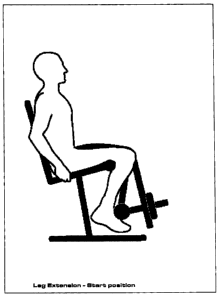Note: Descriptions are shown in the official language in which they were submitted.
CA 02506444 2005-05-06
CYBER ~;fi~,~'~f''~
Andrew Oill
B. Soc Sci, A.C.E.. S.RI.
cybfit~meil.com
613.276.7877
Specification:
1. The purpose of a lenticular biomechanical diagram is to provide a visually
appealing
memory cue as to how an exercise can be both effectively and safely performed.
The diagrams
can be affixed to corresponding exercise equipment or information display
areas. Ideally, several
machines in a fitness facility can be equipped with corresponding diagrams.
For example, a "Leg
Extension" (fig.1 and 2) the lenticular biomechanical diagram illustrates both
the start and finish
movement including the target muscle or muscle groups affected.
2
CA 02506444 2005-05-06
CYBER ~ ~.~~
.. z, x ~> -: t >
Andrew Gill
B. Soc Sci, A.C.E., S.f?I.
cybfit~meil.com
613.276.7A77
This invention answers the periodic difficulty fitness equipment users may
experience
when operating equipment while supervision or instruction may be temporarily
unavailable.
Typical strength equipment may incorporate a basic 2D diagram of the physical
region being
affected. However, quite often the correct biomechanics and posture will not
be addressed. In
many cases fitness equipment is inadequately illustrated or has little or no
user explanation. Or
conversely, there may be too much technical description solely on the set-up
of the equipment.
This invention addresses these concerns.
A lenticular biomechanical diagram incorporating both the start and finish of
an exercise
becomes a very effective visual memory cue. As a result this invention
attempts to amend
incorrect presumptions on how to perform specific exercises effectively, as
well as operate any
corresponding equipment subsequent to instruction and demonstration from a
qualified
fitness trainer.
The invention also communicates and educates users without the need for
specific language
instruction due to the pictorial properties of this application of lenticular
diagrams.
3
CA 02506444 2005-05-06
CYBER
Andr~w Oill
B. Soc Sci. A.C.E., S.PJ.
cybf~il.com
613.278.7877
3. Individuals utilizing exercise equipment require proper work-out form and
posture. Cyberfit
lenticular biomechanical diagrams promote a better understanding of the
biomechanics involved.
The diagrams illustrate how to perform exercises effectively and safely
through the illustration of
correct start and finish form. An additional benefit of affixing the
lenticular diagrams to equipment
or educational literature may also result in the reduction of physical injury
to the individual, as
well as damage to the equipment.
Having lenticular biomechanical diagrams readily available in fitness and
rehabilitation facii'rties
enable the strength training process to be less daunting. The diagrams, when
affixed to fitness
equipment or in printed media, serve as a strong visual reminder on the
correct exercise
procedure. Furthermore, they allow for the development of a strong kinesthetic
awareness of
proper exercise form.
The diagrams may also alleviate the confusion that novice gym users often
experience when
commencing a fitness program. User-friendly lenticuiar biomechanical diagrams
on equipment
and/or information display areas provide additional reinforcement of what has
been
demonstrated by a qualified fitness instructor. Thereby visually anchoring
proper and effective
use of fitness equipment.
4
CA 02506444 2005-05-06
CYBER , f~~~xw .~ ,,
Andrew Oiil
B. Soc Sci, A.C,E.. S.RI.
cybfit~meil.com
613.276.7677
4. The lenticular biomechanical diagrams display one image when viewed at one
angle and
another image when the viewpoint is adjusted slightly. The illustrative images
depict the start and
finish of typical strength training exercises. The correct biomechanical form
including the muscle
groups involved are also depicted. i.e. "lateral pull down' or."leg extension"
The exercise shown in Figure 1 depicts an individual preparing to perform a
leg extension. The
front of the ankle rests under the roller pad at the start position. In Figure
2, the individual raises
the lower leg to the appropriate angle until the front thigh muscles (rectus
femoris, and
quadriceps) are being worked. Care is undertaken not to hyper-extend the knee.
CA 02506444 2005-05-06
GYBER
..#r~ .. s.~<.
Andrew Oill
B. Soc Sci, A.C.E., S.RI.
cybfiG~mail.com
613.276.7877
6. Alternately, lenticular biomechanical diagrams can be utilized in printed
collateral, i.e. a
booklet, pamphlet or poster format. These options allow for correct technique
and motion to be
referred to outside the fitness or strength training facility.
Lenticular biomechanical diagrams can be used to facilitate proper ergonomic
posture in a
variety of work scenarios. Specific strength and stretching exercises can be
adapted for the
alleviation of repetitive stress injuries. Other industries that can benefit
from utilizing lenticular
biomechanical diagrams include: manual labor industries i.e. construction
workers; and
conversely, clerical work i.e. work performed at computer workstations.
6
